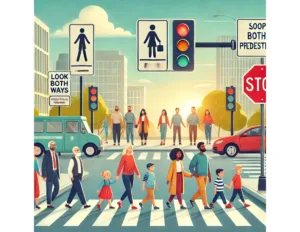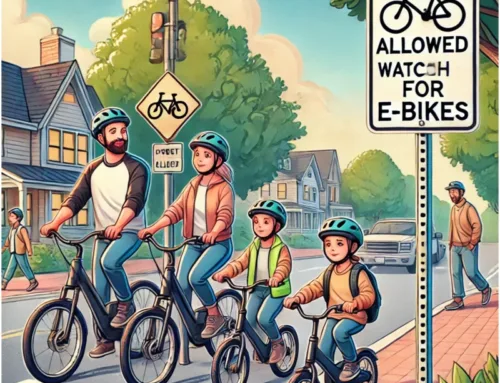Pedestrian Safety Month, observed each October, serves as an important reminder for everyone, whether on foot or behind the wheel, to prioritize safety. Every individual is a pedestrian at some point during the day, making pedestrian safety a shared responsibility. As pedestrian fatalities continue to rise, it’s important to focus on safe driving practices and encourage safer pedestrian behaviors.
The Importance of Pedestrian Safety
Pedestrian fatalities have become an increasing concern. In 2022, there were 7,522 pedestrians killed in traffic crashes across the United States. This number reflects a slight increase from 2021, highlighting the ongoing need for awareness and preventive measures. Whether crossing streets, walking alongside roads, or navigating through intersections, pedestrians remain vulnerable in a world dominated by vehicles.
Contributing Factors to Pedestrian Fatalities
Several factors contribute to the alarming rise in pedestrian fatalities. Some of the most significant include:
- Lack of visibility: According to data, more pedestrian fatalities occurred in the dark (78%) than during daylight hours (19%).
- Alcohol involvement: A significant portion of pedestrian fatalities involves either drivers or pedestrians with a blood alcohol content (BAC) of .08 or higher. In 2022, nearly half (48%) of all pedestrian fatalities involved alcohol.
- Urban areas: Most pedestrian deaths occur in urban areas (85%), where traffic is denser, and pedestrians are often navigating busy intersections.
 These factors emphasize the importance of drivers exercising caution, especially in low-visibility situations and congested urban environments. For pedestrians, staying alert and avoiding distractions such as phones or loud music can help reduce the risk of accidents.
These factors emphasize the importance of drivers exercising caution, especially in low-visibility situations and congested urban environments. For pedestrians, staying alert and avoiding distractions such as phones or loud music can help reduce the risk of accidents.
Safety Tips for Drivers
Drivers play a crucial role in ensuring pedestrian safety. The following are essential safety tips for drivers:
- Yield to pedestrians: Always yield to pedestrians at crosswalks, even if they do not have the right of way. Being vigilant can save lives.
- Avoid speeding: Higher speeds increase both the likelihood and severity of a pedestrian collision. The risk of fatality for a pedestrian hit at 42 mph is 50%, whereas at 32 mph, the risk drops to 25%.
- Avoid distractions: Using a phone or engaging in other distracting activities while driving dramatically reduces the reaction time needed to avoid accidents.
- Drive sober: Impaired driving is a leading cause of pedestrian fatalities. Ensure that you are always sober and alert when behind the wheel.
Safety Tips for Pedestrians
Pedestrians can also take several precautions to stay safe, particularly in high-traffic areas:
- Use crosswalks: Whenever possible, cross streets at marked crosswalks or intersections. Jaywalking or crossing between parked cars increases the risk of not being seen by drivers.
- Stay visible: Wear bright or reflective clothing, especially when walking at night. Carrying a flashlight can also improve visibility.
- Avoid distractions: Just as drivers need to avoid distractions, pedestrians should refrain from using their phones or headphones when crossing streets. Staying aware of your surroundings is key to preventing accidents.
- Follow traffic signals: Obey pedestrian traffic signals and wait for the walk sign before crossing busy streets.
The Role of Communities and Infrastructure
While driver and pedestrian behaviors are essential in reducing fatalities, communities and local governments play a significant role in ensuring pedestrian safety through proper infrastructure planning. Cities can implement several strategies, such as:
- Improved lighting: Increasing street lighting in high-risk areas can help reduce the number of pedestrian fatalities that occur at night.
- Pedestrian islands: Adding islands in the middle of wide streets can give pedestrians a safe space to pause while crossing, especially in urban areas.
- Reduced speed limits: Lowering speed limits in pedestrian-heavy zones significantly reduces the severity of accidents.
The Alarming Rise in Pedestrian Injuries
In addition to fatalities, pedestrian injuries remain a growing concern. In 2022, there were an estimated 67,336 pedestrians injured in traffic-related incidents, an 11% increase from the previous year. These injuries often have long-term effects, impacting victims’ quality of life, mobility, and financial stability. Whether the injuries are minor or severe, they highlight the importance of creating a safer environment for those on foot.
Raising Awareness for Pedestrian Safety Month
Pedestrian Safety Month provides an excellent opportunity for communities, schools, and organizations to raise awareness about pedestrian safety. During this time, various campaigns and programs can be implemented to educate the public on safe walking practices and responsible driving behaviors. Educational materials can be distributed through schools, community centers, and social media platforms to reach a broad audience.
A United Effort Toward Safer Streets
Pedestrian safety requires a united effort from everyone—drivers, pedestrians, city planners, and policymakers. By working together and staying informed about best practices for road safety, we can significantly reduce the number of pedestrian fatalities and injuries.
A Collective Commitment to Pedestrian Safety
Pedestrian Safety Month is a reminder that protecting pedestrians is a shared responsibility. By staying vigilant and making safer choices, we can reduce the number of preventable accidents on our streets. Whether you’re a driver, pedestrian, or part of a community, your actions make a difference. Call us today at 908.264.7701 to learn more about how you can contribute to safer streets.







